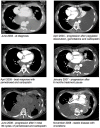Molecular resistance fingerprint of pemetrexed and platinum in a long-term survivor of mesothelioma
- PMID: 22905093
- PMCID: PMC3414492
- DOI: 10.1371/journal.pone.0040521
Molecular resistance fingerprint of pemetrexed and platinum in a long-term survivor of mesothelioma
Abstract
Background: Pemetrexed, a multi-folate inhibitor combined with a platinum compound is the first-line treatment of malignant mesothelioma, but median survival is still one year. Intrinsic and acquired resistance to pemetrexed is common, but its biological basis is obscure. Here we report for the first time a genome-wide profile of acquired resistance in the tumour from an exceptional case with advanced pleural mesothelioma and almost six years survival after 39 cycles of second-line pemetrexed/carboplatin treatment.
Methodology and principal findings: Genome-wide analysis with Illumina BeadChip Kit of 25,000 genes was performed on mRNA from pre-treatment and post-resistance biopsies from this individual as well on case and control samples from our previously published study (in total 17 samples). Cell specific expression of proteins encoded by selected genes were analysed by immunohistochemistry. Serial serum levels of CA125, CYFRA21-1 and SMRP levels were examined. TS protein, the main target of pemetrexed was overexpressed. Proteins and genes related to DNA damage response, elongation and telomere extension and repair related directly and indirectly to platinum resistance were overexpressed, as the CHK1 protein and the genes CHEK2, LIG3, POLD1, POLA2, FANCD2, PRPF19, RECQ5 respectively, the last two not previously described in mesothelioma. We observed a down-regulation of leukocyte transendothelial migration and cell adhesion molecules pathways. Silencing of NT5C in two mesothelioma cell lines did not sensitize the cells to Pemetrexed. Proposed resistance markers are TS, KRT7/ CK7, TYMP/ thymidine phosphorylase and down-regulated SPARCL1 and CDKN1B. Moreover, comparison of the primary expression of the sensitive versus a primary resistant case showed multi-fold overexpressed DNA repair, cell cycle, cytokinesis, and spindle formation in the latter. Serum CA125 and SMRP reflected the clinical and radiological course and tumour burden.
Conclusions: Genome-wide microarray of mesothelioma pre- and post-resistance biopsies indicated a novel resistance signature to pemetrexed/carboplatin that deserve validation in a larger cohort.
Conflict of interest statement
Figures









References
-
- Vogelzang NJ, Rusthoven JJ, Symanowski J, Denham C, Kaukel E, et al. (2003) Phase III study of pemetrexed in combination with cisplatin versus cisplatin alone in patients with malignant pleural mesothelioma. J Clin Oncol 21: 2636–2644. - PubMed
-
- Righi L, Papotti MG, Ceppi P, Bille A, Bacillo E, et al. (2010) Thymidylate synthase but not excision repair cross-complementation group 1 tumor expression predicts outcome in patients with malignant pleural mesothelioma treated with pemetrexed-based chemotherapy. J Clin Oncol 28: 1534–1539. - PubMed
-
- Ceppi P, Monica V, Righi L, Papotti M, Scagliotti GV (2010) Emerging role of thymidylate synthase for the pharmacogenomic selection of patients with thoracic cancer. Int J Clin Pharmacol Ther 48: 481–482. - PubMed
-
- Zucali PA, Giovannetti E, Assaraf YG, Ceresoli GL, Peters GJ, et al. (2010) New tricks for old biomarkers: thymidylate synthase expression as a predictor of pemetrexed activity in malignant mesothelioma. Ann Oncol 21: 1560–1561. - PubMed
Publication types
MeSH terms
Substances
LinkOut - more resources
Full Text Sources
Medical
Research Materials
Miscellaneous

